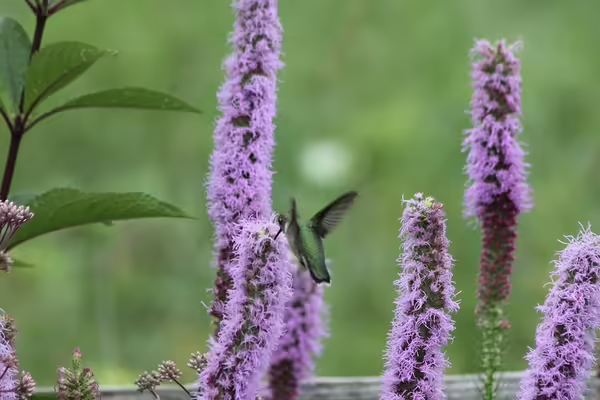
URBANA, Ill. — Hummingbirds are unlike any other bird. Spanning the Americas with over 330 species, hummingbirds belong to Trochilidae, the second-largest bird family in the world. However, only the ruby-throated hummingbird (Archilochus colubris) inhabits the Midwest. This hummingbird migrates south in late summer, with the males migrating first, typically in August. Before the non-stop flight to overwintering sites, this bird needs abundant food sources to fuel its journey to Florida, Texas, Central America, or Mexico.
Often, hummingbirds prefer open habitats along forest edges or areas with scattered trees, including urban areas. So it is possible to have them visit any urban or suburban property if the locations have plants they prefer. Once a hummingbird detects those plants, it often returns around the same time each year. They typically nest in trees or other protected areas, though some have been spotted nesting on top of a wind chime. Moss and lichens are used to camouflage nests made of hairs, spider silk, and plant fibers.
Planting for Hummingbirds
There are many ways to support hummingbirds. A container of their preferred plants will invite them to a patio or balcony. Growing plants vertically, including vines, can maximize any space. If you have space, plan to incorporate a steady supply of nectar blooms during each season, especially during migration. Plant species in clumps of at least three so hummingbirds will recognize the blocks of color.
With their long beaks, hummingbirds feed on the nectar of tubular flowers. They have a preference for red, orange, and pink blooms but can be seen visiting other types of flower structures and colors. For instance, black and blue salvia is a favorite tubular flower, although it is purple. Also, remember that all flowers are not created equally. Double flowers and some cultivars do not produce valuable nectar. Other red showy flowers like geraniums and roses will draw the attention of hummingbirds but do not offer as much nectar as natives and tubular flowers.
A few suggested plants native to Illinois and the U.S. that they prefer include red columbine (Aquilegia canadensis), cardinal flower (Lobelia cardinalis), trumpet honeysuckle (Lonicera sempervirens), and Bee Balm (Monarda didyma). Hummingbirds have also been observed visiting other Illinois natives, like prairie blazing star (Liatris pycnostachya) and foxglove beardtongue (Penstemon digitalis). Preferred annuals include canna (Canna indica), red hot poker (Kniphofia hirsute), cigar plant (Cuphea ignea), cardinal climber (Ipomoea x multifida), and tall red varieties of zinnia (Zinnia elegans).
Supporting Beyond the Blooms
When blooms are scarce, hummingbird feeders work well for supplemental food. A ratio of 4:1 water to white granulated sugar can be used in hummingbird feeders. Other additions to landscapes include water baths, trees for perching within 10 to 20 feet of the garden, dead branches and twigs may be substituted, and fuzzy plants for nesting materials. Avoid using insecticides since hummingbirds also eat insects, and do not use systemic herbicides because they are persistent in flowers.
With the importance of supporting pollinators, plan to incorporate plants for hummingbirds in gardens. Hopefully, adding hummingbird-preferred plants will allow more growers the chance to experience these incredible creatures in action. They certainly aren't afraid of humans, so many are able to experience a quick, close encounter.
Nancy Kreith is a University of Illinois Extension horticulture educator for Cook County. Gardeners Corner is a quarterly newsletter from gardening experts around the state. Each issue highlights best practices that will make your houseplants, landscape, or garden shine in any season. Join the Gardener’s Corner email list at go.illinois.edu/GCsubscribe for direct access to timely tips.
PHOTO CAPTION: A Ruby-throated hummingbird on a native prairie blazing star. Photo by Nancy Kreith, Illinois Extension.
Illinois Extension leads public outreach for University of Illinois by translating research into action plans that allow Illinois families, businesses, and community leaders to solve problems, make informed decisions, and adapt to changes and opportunities. Illinois Extension is part of the University of Illinois Urbana-Champaign College of Agricultural, Consumer and Environmental Sciences.